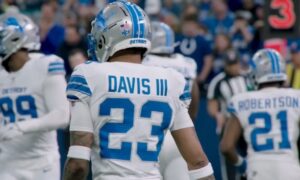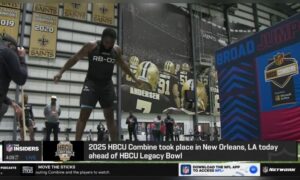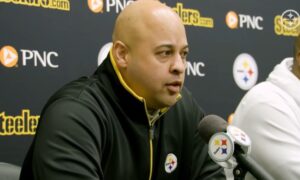It’s said a draft class can’t be fully graded until at least three years after the picks are made. That’s why after submitting grades for every Pittsburgh Steelers pick made in 2021, I began going back through and grading previous Steeler draft classes beginning with 2018. Today continues the third class in that exercise, with the Steelers’ third-round pick in the 2016 NFL Draft: Javon Hargrave, a defensive tackle from South Carolina State.
This exercise follows the six viewpoints (listed below) for examining and re-grading a pick. Each of the first five viewpoints gets examined and assigned a letter grade, before taking that analysis and combining it into a final letter grade. Those five viewpoints comprise much of what goes into the draft grades consumed by so many every year after the draft.
Steelers’ Career: What did the player contribute to the team that drafted him?
NFL Career: Did the player make the pick look better in hindsight after leaving Pittsburgh?
Pick Value: Did the player outperform his draft slot? Did he fail to live up to the pick used on him?
Positional Value: Was the player the best player remaining at his specific position in the draft?
Other Options: Did any players go during the next round that were better selections?
Overall Grade: A final mark to denote whether the selection was an overall positive one, or one better spent elsewhere.
Each factor in a retrospective doesn’t apply evenly to every pick made; consider the grades weighted. For example, to return a high grade in pick value, a first-round pick should have a long and impactful career, while a later-round pick needs only a couple seasons as a back-up or modest contributor to be worth the selection used on him.
Some factors are universal, though. Whether picked first overall or 259th, there will always be other options on the board to compare the player to, and steals and reaches can come from any place in the draft.
Round 3, Pick 26: Javon Hargrave, DT, South Carolina State
STEELERS CAREER: A-
Hargrave saved his best season with the Steelers for his contract year, but the FCS defensive tackle was a full-time contributor for Pittsburgh from the season he was drafted. He started 13 games as a rookie and at least 12 in all four of his seasons with the team.
Beginning with 27 tackles in 2016, Hargrave increased that number every season to a peak of 60 in his last year in Pittsburgh. His tackles for loss also increased to a high of seven in 2019, and he recorded 10.5 sacks his final two years after only four his first two.
Hargrave’s role grew right alongside his numbers. Even in his first couple seasons, Hargrave was more than serviceable as a nose tackle for the Steelers. His final two seasons, though, he took major steps forward to becoming the Casey Hampton-type player in the middle of the team’s defensive line. Hargrave was able to generate consistent pressure from the middle (his 43 hurries in 2019 nearly matched his combined total from three prior seasons), and was a definite run-stuffer by the time he reached free agency.
Hargrave’s career line in Pittsburgh over four seasons was 168 tackles (106 solo), 22 tackles for a loss, 22 QB hits, 92 hurries, 14.5 sacks, two forced fumbles, and a fumble recovery. The numbers aren’t the biggest, but also don’t display the type of role Hargrave earned himself on the team by the time he reached free agency following the 2019 season.
NFL CAREER: B
Pittsburgh elected to franchise tag Bud Dupree following the 2019 season. With limited cap space to work with following that move, Hargrave reached free agency and signed a three-year, $39 million contract with the Philadelphia Eagles.
His lone year thus far in Philadelphia saw regression in Hargrave’s production as he went from a nose tackle role in Pittsburgh to a four-man line featuring All-Pro Fletcher Cox and Pro Bowler Brandon Graham, as well as a third defensive tackle in the rotation in Malik Jackson.
Playing 601 snaps, Hargrave had 38 tackles (five for a loss) and 4.5 sacks, making 11 starts. It was his fewest tackles since 2017 and fewest for a loss since 2016, but he did stay productive in rushing the passer by matching his career-high with eight QB hits, and had 28 hurries. Not a duplicate of his final season in Pittsburgh which helped earn him $13 million a year in Philly, but still a quality year overall given the difference in how he was used with the Eagles compared with the Steelers. And with Jackson gone this offseason, there’s only more snaps available to him in 2021.
PICK VALUE: A
There shouldn’t be any arguments that this was some outstanding value, easily the best Pittsburgh received from a pick in this class. The Steelers got four years of a starter who at worst was average and at best was one of the best defensive tackles in the NFL, and they got that player with a selection just before the start of Day 3. Hargrave might not break the first round in a re-draft, but he isn’t falling anywhere near this far.
POSITIONAL VALUE: A-
Apologies to David Onyemata, who after a strong 2020 with New Orleans appears on his way to a major breakout and jump in status among NFL defensive tackles. But no defensive tackle taken after Hargrave has matched what Hargrave’s done in his NFL career. Honestly, a lot of the ones taken before him have had trouble, too.
Onyemata (New Orleans, 120th) is closest. He earned a starting job with the Saints in 2019, and set new career highs with 44 tackles, 10 tackles for a loss, 16 QB hits, and 6.5 sacks last season in 15 games. As this tweet by Establish the Run’s Brandon Thorn shows, Onyemata was one of the most productive tackles in the game last season. Hargrave’s longevity is more impressive, but another year of growth from Onyemata will rank him higher.
The rest of the class has had moments, but fleeting ones. Matthew Ioannidis (152nd, Washington) started a couple seasons, but did so as an end. Quinton Jefferson (147th, Seattle) did the same but stuck at tackle, and shifted back to a back-up role last year. Anthony Zettel (202nd, Detroit) looked like a future star after a breakout 2017, but has played five games the last two years. Debate Hargrave/Onyemata all you want, because those are the only two names with staying power at defensive tackle from the 2016 class taken 89th or later.
OTHER OPTIONS: B+
That debate between the two can carry over to here, because Onyemata was one of the players selected in the 32 picks after Hargrave. A lot of the top talent in that range came on the defensive side of the ball. Justin Simmons, mentioned in yesterday’s Sean Davis retrospective, is the highest-paid safety in football, and the best player taken in that range, going 98th to Denver.
Also going on defense were several linebackers. Joe Schobert was a bright spot and Pro Bowler in Cleveland after going 99th. Now with Jacksonville, he has four 100-tackle seasons, and three of them featured 130 or more tackles. The other LBs don’t reach his numbers, but B.J. Goodson nearly hit 100 tackles for the Browns last season and started half or all of the last four years. He remains a free agent, but Nick Kwiatkoski is on his second year starting for Las Vegas.
Graham Glasgow (95th, Detroit) started all five of his seasons for Detroit and Denver, and Jacoby Brissett (91st, New England) showed tangible flashes in two seasons starting for Indianapolis. Hargrave’s status has him above all those players and in a tier with Simmons and Schobert, who are the only two (again, with the possibility of Onyemata) that might offer a better result with this pick.
OVERALL GRADE: A
The productive player on defense that Pittsburgh missed on with its first two picks in 2016, it found with its third selection. Hargrave gave the Steelers the exact nose tackle they needed to take the steps to become one of the NFL’s best defenses. His production both in stats and on-field impact was worth a lot more than a late Day 2 selection, a case only made stronger as Hargrave improved every season with the team. Financial constraints forced Pittsburgh to let him leave for free agency, where Hargrave has continued to play well across the state in Philadelphia. He continues to outplay his draft slot there. This is an excellent example of a team and its scouting department finding a small-school star, and capitalizing on it.








